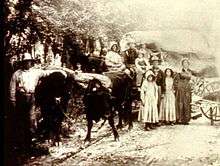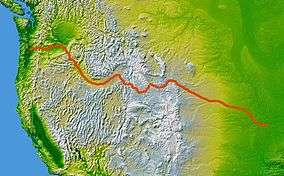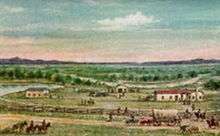Sager orphans

The Sager orphans (sometimes referred to as the Sager children) were the children of Henry and Naomi Sager. In April 1844 the Sager family took part in the great westward migration and started their journey along the Oregon Trail. During it, both Henry and Naomi lost their lives and left their seven children orphaned. Later adopted by Marcus and Narcissa Whitman, missionaries in what is now Washington, they were orphaned a second time, when both their new parents were killed during the Whitman massacre in November 1847. About 1860 Catherine, the oldest girl, wrote a first-hand account of their journey across the plains and their life with the Whitmans. Today it is regarded as one of the most authentic accounts of the American westward migration.
The children's names were (from oldest to youngest):
- John Carney Sager (born 1831 in Union County, Ohio)
- Francis "Frank" Sager (born 1833 in Union County, Ohio)
- Catherine Carney Sager (born April 15, 1835 in Union County, Ohio)
- Elizabeth Marie Sager (born July 6, 1837 in Union County, Ohio)
- Matilda Jane Sager (born October 6, 1839 in Buchanan County, Missouri)
- Hannah Louise "Louisa" Sager (born 1841 in Platte County, Missouri)
- Henrietta Naomi "Rosanna" Sager (born May 30, 1844 along the Oregon Trail in present-day Kansas)
Before the Oregon Trail
Henry Sager was described as a restless one by his daughter, Catherine. Before 1844 he had moved his growing family three times. Starting in Virginia they moved to Ohio, later to Indiana before finally arriving in Platte County, Missouri. There, backed by his two sons, John and Francis, he decided to head for Oregon, the fabled territory in the Pacific Northwest. Naomi was reluctant to go, at first, but eventually agreed. In late autumn 1843, they reached St. Joseph, Missouri, a jump-off point for the Oregon Trail. At this time she was already pregnant with her seventh child. Over the winter they stayed in St. Joseph where in March 1844 Henry joined a group of pioneers who called themselves The Independent Colony.
On the Oregon Trail

At the end of April 1844, the Independent Colony, 300 people in 72 covered wagons, crossed the Missouri River and started out on the 2,000-mile (3,200 km) journey along the Oregon Trail. The company was under the command of Captain William Shaw, who was traveling with his wife, Sally, and six children. After five weeks on the trail Naomi gave birth to their seventh child, a girl named Henrietta. Due to the delivery, she was weakened and only slowly regained her strength.

On July 4, 1844, the Independent Colony celebrated Independence Day on the banks of the Platte River. A couple of days later, while crossing its south fork, Naomi was severely injured as the Sager wagon overturned in the shallow waters along the bank. But the pioneers pressed on. At the end of July 1844 the wagon train passed Chimney Rock, a famous landmark along the trail in what is now Nebraska. It was the reminder that the Great Plains were almost crossed and the Rocky Mountains lay right ahead.
A few hours before reaching Fort Laramie, Catherine caught her dress on an axe handle when she jumped out of the moving wagon. Her leg, trapped beneath one of the heavy wheels, was broken several times, an event that could have easily been fatal under the medical and sanitary conditions of that situation. But due to the immediate treatment by Henry and Dr. Dutch, a German-born doctor, her leg was eventually saved. She, however, was confined to the wagon for the rest of the journey. From Fort Laramie onward, Dr. Dutch stayed with the Sagers in order to care for her injury. Thus the wagon train moved on and a couple of days later the Independent Colony reached Independence Rock in present-day Wyoming, where some of the travelers carved their names into the granite rock.
The deaths of Henry and Naomi Sager
On August 23, 1844, the wagon train reached South Pass, a high plains pass that is on the Continental Divide. During the descent into the Green River valley some of the travelers fell ill due to an outbreak of camp fever. Amongst those suffering was Henry. After crossing the Green River, two women and a child were already dead, and it became evident that Henry wouldn't live through the night. He asked Captain Shaw to take care of his family and died soon afterwards. He was buried by them on the banks of the Green River in an improvised coffin.
Naomi, still weakened from childbirth and mourning her husband, now had all the responsibility for the seven children. Although Captain Shaw and Dr. Dutch did everything possible to assist her, the exertions were too much. Suffering from heavy fever she became delirious and finally requested Dr. Dutch to squire the children to Marcus Whitman, a missionary in the Walla Walla Valley of what is now southeastern Washington. She died near present-day Twin Falls, Idaho. Her last words were "Oh Henry, if you only knew how we have suffered". As there was no lumber available, she was buried wrapped in a bedsheet. John, the oldest child, carved the words Naomi Carney Sager, age 37 out of a wooden headboard and thus marked the shallow grave. The children, the youngest three months and the oldest thirteen years, were orphaned for the first time.
The Whitman years

In 1837 Narcissa Whitman, aged 29, gave birth to a daughter, Alice Clarissa. Two years later, she was distracted for a moment and Alice drowned in the nearby Walla Walla River, having gone there to fill her cup with water. She suffered deeply from this loss. In an attempt to regain some sense of family she began taking care of other children. Soon four were in their custody, including the daughters of mountain men Joseph Meek and Jim Bridger.
In early October 1844, the Independent Colony reached the Whitman Mission, and the Sager orphans found a new home with Narcissa. In July 1845 Marcus obtained a court order giving him legal custody of them. They had new parents.
The deaths of Marcus and Narcissa Whitman
Marcus was a physician and a Protestant missionary. In 1836 he and Narcissa, together with a group of other missionaries, joined a caravan of fur traders and traveled west, establishing several missions as well as their own settlement. Located in the Walla Walla Valley on the northern end of the Blue Mountains near the present day city of Walla Walla, Washington, it was in the territory of both the Nez Percé and the Cayuse Native American tribes. The latter called it Waiilatpu (Why-ee-lat-poo, the 't' is half silent), which means "place of the rye grass" in the Cayuse language. Marcus farmed and provided medical care, while Narcissa set up a school for the Native American children. In the early days, life was peaceful at the Whitman Mission. But the peaceful coexistence of the local Cayuse and the white missionaries was in a delicate balance, and in 1847, three years after the arrival of the Sager orphans, the balance began to shift to distrust and animosity.
The number of wagon trains and pioneers had increased significantly since 1843. The settlers inadvertently brought with them diseases the Indians had no immunity to. In the fall of 1847 measles carried west with an emigrant train swept through the Cayuse villages. In the cold and damp weather of November 1847 the epidemic reached its peak and half the tribe died, including most of the children. On November 29, 1847 the situation erupted into violence. A man from the east named Joe Lewis, hoping to create a situation in which he could ransack the Whitman Mission, spread the rumor among the local Cayuse that Marcus, who was attempting to treat them during the epidemic, was in fact deliberately poisoning them. On November 29, 1847, the Cayuse attacked Waiilatpu.
The Whitman massacre ended with the death of fourteen people at the mission, including Marcus, Narcissa, and John and Francis Sager. Another fifty-four women and children were captured and held for ransom, including the daughters of Joseph Meek and Jim Bridger and all the Sager girls. Several of the prisoners died in captivity, mostly from illnesses such as measles, including Helen Mar Meek and Louisa Sager. One month after the massacre, on December 29, 1847, Peter Skene Ogden from the Hudson's Bay Company arranged an exchange of sixty-two blankets, sixty-three cotton shirts, twelve rifles, six hundred loads of ammunition, seven pounds of tobacco, and twelve flints for the return of the forty-nine surviving prisoners. They were brought to Fort Vancouver and released into freedom.
After the Whitman massacre

At this point family life ended for the remaining four Sager orphans. The girls were split up and grew up with different families. All of them married young.
- Henrietta had no children. She died at the age of 26, having been mistakenly shot by an outlaw.
- Matilda had 8 children. She spent her later life with a daughter in California, where she died on April 13, 1928 at the age of 89.
- Elizabeth had 9 children. She lived in Portland, Oregon, where she died on July 19, 1925 at the age of 88.
- Catherine married Clark Pringle, a Methodist minister and bore him 8 children. They lived in Spokane, Washington. About ten years after her arrival in Oregon she wrote an account of the Sager family's journey west. She hoped to earn enough money to set up an orphanage in memory of Narcissa Whitman. She never found a publisher. She died on August 10, 1910 at the age of 75. Her children and grandchildren saved her manuscript without modification, and today it is regarded as one of the most authentic accounts of the American westward migration.
In 1897, more than 3,000 visitors attended the 50th anniversary commemoration of the massacre on the mission grounds. Invited as guests of honor were some of the survivors of the events of 1847, including Catherine Sager Pringle, Elizabeth Sager Helm, and Matilda Sager Delaney, the last surviving Sager orphans.
Sources
- Catherine Sager Pringle, Across the Plains in 1844.
- National Park Service – Whitman Mission NHS, The True Story of the Sagers.
- Mary Trotter Kion, The Sagers go West.
- Erwin N. Thompson, Shallow Grave at Waiilatpu: The Sagers' West (1969).
- Ken Burns, The West, Transcript of the PBS documentary.
External links
- Catherine Sager-Pringle: Across the Plains in 1844
- The True Story of the Sagers National Park Service - Whitman Mission National Historic Site
- The Oregon Trail (Collection of historic sources of the Oregon Trail)
- Diaries, Memoirs, Letters and Reports Along The Trails West